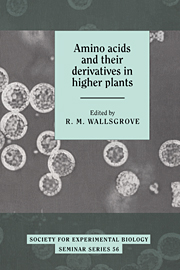Book contents
- Frontmatter
- Contents
- List of contributors
- Preface
- Glutamine synthetase in higher plants: molecular biology meets plant physiology
- Interactions of nitrogen and carbon metabolism: implications of PEP carboxylase and isocitrate dehydrogenase
- The genetics of aspartate derived amino acids in higher plants
- Oxidation of 1-aminocyclopropane-1-carboxylic acid (ACC) in the generation of ethylene by plants
- Regulation of carbon flow through the branched chain amino acid biosynthetic pathway
- Amino acid metabolism and protein deposition in the endosperm of wheat: synthesis of proline via ornithine
- The glycine decarboxylase complex in higher plant mitochondria: structure, function and biogenesis
- Glycine and serine synthesis in non-photosynthetic tissues
- Biogenesis of N-heterocydic amino acids by plants: mechanisms of biological significance
- Toxicity of non-protein amino acids from plants
- Processes involved in glutathione metabolism
- Betaines in higher plants – biosynthesis and role in stress metabolism
- Metabolism and function of polyamines during osmotically induced senescence in oat leaves and protoplasts
- Biosynthesis of cyanogenic glucosides. Elucidation of the pathway and characterization of the cytochromes P-450 involved
- The biosynthesis of glucosinolates in Brassicas
- Biochemical genetics of aliphatic glucosinolates in Brassica and Arabidopsis
- Index
Regulation of carbon flow through the branched chain amino acid biosynthetic pathway
Published online by Cambridge University Press: 09 April 2010
- Frontmatter
- Contents
- List of contributors
- Preface
- Glutamine synthetase in higher plants: molecular biology meets plant physiology
- Interactions of nitrogen and carbon metabolism: implications of PEP carboxylase and isocitrate dehydrogenase
- The genetics of aspartate derived amino acids in higher plants
- Oxidation of 1-aminocyclopropane-1-carboxylic acid (ACC) in the generation of ethylene by plants
- Regulation of carbon flow through the branched chain amino acid biosynthetic pathway
- Amino acid metabolism and protein deposition in the endosperm of wheat: synthesis of proline via ornithine
- The glycine decarboxylase complex in higher plant mitochondria: structure, function and biogenesis
- Glycine and serine synthesis in non-photosynthetic tissues
- Biogenesis of N-heterocydic amino acids by plants: mechanisms of biological significance
- Toxicity of non-protein amino acids from plants
- Processes involved in glutathione metabolism
- Betaines in higher plants – biosynthesis and role in stress metabolism
- Metabolism and function of polyamines during osmotically induced senescence in oat leaves and protoplasts
- Biosynthesis of cyanogenic glucosides. Elucidation of the pathway and characterization of the cytochromes P-450 involved
- The biosynthesis of glucosinolates in Brassicas
- Biochemical genetics of aliphatic glucosinolates in Brassica and Arabidopsis
- Index
Summary
The branched chain amino acid biosynthetic pathway has received considerable attention in recent years because different chemical classes of highly successful commercial herbicides kill plants by inhibiting this pathway. This discovery has led to identification and design of other inhibitors of this pathway that are also herbicidal. Our recent studies on the mode of action of imidazolinone herbicides have provided clues that may help clarify the role of 2-ketobutyrate and 2-aminobutyrate in the phytotoxic effects of these herbicides. These studies have also provided insight into understanding the regulation of carbon flow through the branched chain amino acid biosynthetic pathway in plants. We have also identified a new form of threonine dehydratase (TD; EC 4.2.1.16) that may have a crucial function in nitrogen metabolism in senescing leaves.
Accumulation of 2-KB/2-AB vs phytotoxidty of AHAS inhibitors
The imidazolinone and sulfonylurea families of highly successful commercial herbicides kill plants by inhibiting acetohydroxyacid synthase (AHAS; EC 4.1.3.18), the first common enzyme in the pathways leading to the biosynthesis of valine, leucine and isoleucine. These extremely potent herbicides kill plants at application rates of grams per hectare. The high potency of AHAS inhibiting herbicides is of great interest because inhibitors of other enzymes in the branched chain amino acid pathway require much higher rates to kill plants (Wittenbach, Aulabaugh & Schloss, 1991; Shaner & Singh, 1992).
- Type
- Chapter
- Information
- Amino Acids and their Derivatives in Higher Plants , pp. 59 - 76Publisher: Cambridge University PressPrint publication year: 1995



